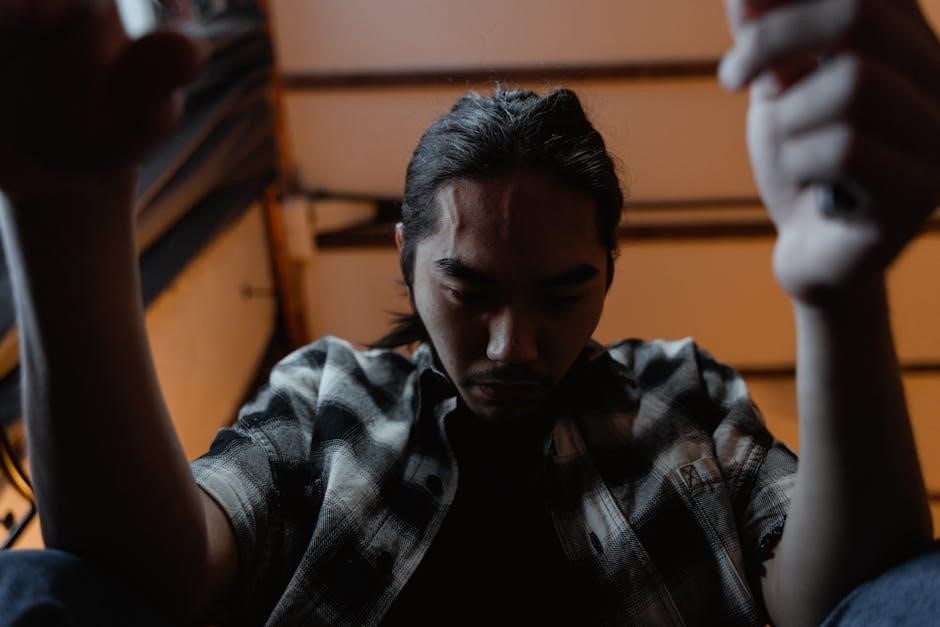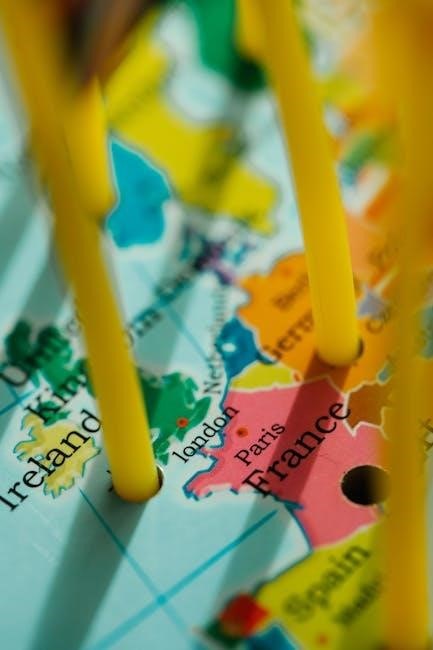Understanding Internalized Homophobia
Internalized homophobia refers to the absorption of societal prejudices, leading individuals to harbor self-hatred or shame regarding their sexual orientation, often manifesting as negative self-talk or self-doubt․
1․1․ Defining Internalized Homophobia
Internalized homophobia is a psychological phenomenon where individuals unconsciously adopt and internalize society’s prejudiced views about homosexuality․ This can lead to self-hatred, shame, and self-doubt, as individuals struggle to reconcile their sexual orientation with societal expectations․ It often stems from exposure to homophobic messages, cultural norms, or religious beliefs that condemn same-sex attraction․ This internal conflict can profoundly affect self-perception and mental health, making it a critical concept to address in overcoming shame and fostering self-acceptance․
1․2․ The Psychological Impact of Internalized Homophobia
Internalized homophobia can lead to profound psychological distress, including depression, anxiety, and low self-esteem․ Individuals may experience self-hatred, shame, and a deep-seated fear of rejection, which can impair their ability to form healthy relationships․ This internal conflict often stems from societal condemnation of same-sex attraction, leading to a fragmented sense of self․ The psychological toll can manifest as self-destructive behaviors, social withdrawal, or a constant struggle for self-acceptance, making it a critical issue to address in overcoming shame and fostering mental well-being․
1․3․ How Society and Culture Contribute to Internalized Homophobia
Society and culture play a significant role in fostering internalized homophobia through negative stereotypes, lack of representation, and discriminatory norms․ Media often portrays LGBTQ+ individuals in harmful or marginalizing ways, reinforcing self-doubt․ Religious and family environments may condemn homosexuality, leading to feelings of guilt․ Legal and institutional discrimination further perpetuate shame․ These external factors internalize as self-hatred and a belief in one’s own inferiority, making it challenging to embrace one’s true identity and contributing to ongoing psychological distress․

Recognizing the Signs of Internalized Homophobia
Signs include self-hatred, shame, fear of rejection, and social isolation, stemming from societal prejudices and lack of acceptance, often manifesting as internal conflict and emotional distress․
2․1․ Self-Hatred and Negative Self-Talk
Self-hatred and negative self-talk are common manifestations of internalized homophobia, where individuals direct societal prejudice inward․ This can lead to critical inner voices, self-doubt, and feelings of inadequacy․ People may experience intense self-criticism for their sexual orientation, viewing themselves as flawed or unacceptable․ This internal conflict often stems from societal norms and upbringing, fostering a cycle of self-blame․ Recognizing these patterns is crucial, as they can hinder self-acceptance and contribute to emotional distress, making it essential to address and challenge such harmful narratives․
2․2․ Shame and Guilt Related to Sexual Orientation
Shame and guilt are profound emotional responses tied to internalized homophobia, often stemming from societal or familial rejection of one’s sexual orientation․ These feelings can manifest as self-blame for experiencing attraction or intimacy, leading to emotional distress․ Shame may cause individuals to hide their true selves, fearing judgment, while guilt can arise from internalizing messages that label their orientation as immoral․ Addressing these emotions requires self-compassion and understanding, as they are rooted in external biases rather than personal flaws․ Recognizing and challenging these feelings is crucial for healing and self-acceptance․
2․3․ Fear of Rejection and Social Isolation
Fear of rejection and social isolation are common manifestations of internalized homophobia, often rooted in the anticipation of discrimination or judgment․ This fear can lead individuals to conceal their true identity, avoiding intimate relationships or social interactions․ The emotional burden of constantly hiding oneself can result in profound loneliness and disconnection․ Overcoming this requires building trust in supportive environments and fostering self-compassion to challenge the deeply ingrained belief that one’s sexual orientation is a source of rejection․ Addressing these fears is essential for emotional well-being and connection․
The Role of Upbringing and Environment
Family, religious, and societal influences shape self-perceptions․ Negative upbringing environments, bullying, and lack of representation can deeply internalize homophobic beliefs, leading to emotional distress and self-doubt․
3․1․ Family and Religious Influences
Family and religious environments play a significant role in shaping self-perceptions․ Negative reactions from family members or religious teachings that condemn homosexuality can internalize feelings of shame and worthlessness, fostering self-hatred and emotional distress․ These influences often lead to a deep-seated conflict between personal identity and societal or familial expectations, making self-acceptance a challenging journey․
Religious doctrines that view homosexuality as immoral can amplify feelings of guilt and self-loathing, while unsupportive family environments may reinforce internalized homophobia, creating a cycle of self-doubt and isolation that persists into adulthood․
3․2․ The Impact of Bullying and Discrimination
Bullying and discrimination can profoundly exacerbate internalized homophobia, fostering negative self-perceptions and self-hatred․ Experiences of ridicule, exclusion, or harassment often lead to feelings of inadequacy and shame, reinforcing the belief that one’s sexual orientation is unacceptable․ These traumatic events can result in long-term emotional scars, including anxiety, depression, and a deep-seated fear of rejection․ The isolation that follows such incidents further entrenches internalized homophobia, making self-acceptance and self-love particularly challenging to achieve․
3․3․ Lack of Representation and Visibility
A lack of representation and visibility in media, culture, and society can exacerbate internalized homophobia․ When individuals rarely see reflections of themselves in positive, affirming contexts, it can foster feelings of isolation and invisibility․ This absence often perpetuates the belief that being LGBTQ+ is abnormal or less valuable, further internalizing shame and self-doubt․ The scarcity of role models and relatable narratives makes it harder for individuals to reconcile their identity, contributing to a sense of alienation and invalidation that compounds internalized homophobia․
The Emotional and Psychological Effects
Internalized homophobia can lead to severe emotional distress, including chronic anxiety, depression, and low self-esteem, significantly impacting mental health and overall well-being․
4․1․ Mental Health Consequences: Depression and Anxiety
Internalized homophobia often manifests as chronic depression and debilitating anxiety, stemming from self-hatred and societal rejection․ These mental health struggles can intensify feelings of worthlessness and isolation, making daily life challenging․ The internal conflict between one’s true identity and societal expectations frequently leads to mood disorders․ Without proper support, these issues can escalate, affecting relationships, work, and overall well-being․ Seeking therapy or joining support groups can provide relief and foster healing from these profound psychological wounds․
4․2․ Struggles with Self-Esteem and Confidence
Internalized homophobia often erodes self-esteem, fostering feelings of inadequacy and self-doubt․ Individuals may struggle to embrace their identity, fearing societal judgment or rejection․ Negative self-talk and self-criticism exacerbate these challenges, making it difficult to build confidence․ This internal conflict can hinder personal growth and relationships, as self-worth becomes tied to unattainable societal standards․ Rebuilding self-esteem requires self-compassion, acceptance, and support from affirming communities or therapy, helping individuals reclaim their value and confidence in their authentic selves․
4․3․ Difficulty Forming Healthy Relationships
Internalized homophobia can hinder the formation of healthy relationships by fostering fear of rejection, mistrust, or intimacy issues․ Shame and self-doubt may lead to isolation or attraction to harmful dynamics․ Individuals might struggle to communicate openly about their needs or feel unworthy of love, sabotaging relationships․ Therapy and support systems can help address these patterns, fostering self-acceptance and the ability to form authentic, fulfilling connections․ Healing involves recognizing and challenging internalized biases to build trust and emotional intimacy with others;

Strategies for Overcoming Internalized Homophobia
Effective strategies include cognitive-behavioral techniques, building supportive networks, and practicing self-compassion․ These methods help individuals reframe negative beliefs and foster self-acceptance, leading to emotional healing and growth․
5․1․ Cognitive-Behavioral Techniques for Changing Negative Thoughts
Cognitive-behavioral techniques help individuals identify and challenge negative thought patterns rooted in internalized homophobia․ By restructuring harmful beliefs, people can replace self-criticism with affirming thoughts․ Techniques include identifying distortions, reframing perspectives, and practicing mindfulness․ These strategies empower individuals to recognize societal influences and develop a more compassionate self-view․ Over time, this process fosters emotional resilience and self-acceptance, reducing the grip of internalized shame and fostering a healthier mental state․ Consistent practice is key to lasting change and personal growth․
5․2․ Practicing Self-Compassion and Self-Forgiveness
Practicing self-compassion involves treating oneself with kindness, especially when grappling with internalized homophobia․ This includes acknowledging pain without judgment and offering understanding․ Self-forgiveness allows individuals to release guilt tied to their sexual orientation, fostering emotional healing․ By embracing their humanity and recognizing societal influences, people can cultivate acceptance․ Activities like journaling, mindfulness, or affirmations can help reinforce these practices, promoting a more nurturing relationship with oneself and countering harmful self-perceptions rooted in shame․
5․3․ Building a Supportive Social Network
Building a supportive social network is crucial for overcoming internalized homophobia․ Surrounding oneself with understanding friends, family, or LGBTQ+ communities fosters acceptance and reduces feelings of isolation․ Engaging in support groups or online forums can provide safe spaces to share experiences and receive encouragement․ Connecting with others who understand the journey of self-acceptance helps counteract negative societal messages․ A strong support system aids in rebuilding self-esteem and provides emotional sustenance, enabling individuals to thrive and live authentically․

The Importance of Community and Allyship
Community and allyship play vital roles in combating internalized homophobia by fostering acceptance and support․ Allies amplify LGBTQ+ voices, promoting inclusivity and challenging harmful stereotypes, while communities provide safe spaces for healing and growth․
6․1․ Finding LGBTQ+-Affirming Communities
LGBTQ+-affirming communities provide safe spaces for individuals to embrace their identities without fear of judgment․ These communities foster acceptance, offering support groups, events, and resources that promote self-acceptance and empowerment․ Engaging with such networks helps individuals build confidence and resilience, counteracting the effects of internalized homophobia․ Online forums, local LGBTQ+ centers, and national organizations are valuable resources for connecting with affirming communities․ Surrounding oneself with understanding peers and allies can significantly aid in overcoming shame and self-hatred, promoting personal growth and well-being․
6․2․ The Role of Allies in Promoting Acceptance
Allyship plays a vital role in fostering acceptance and combating internalized homophobia․ Allies amplify LGBTQ+ voices, challenge harmful stereotypes, and create inclusive environments․ By educating themselves about LGBTQ+ issues, allies can actively support individuals in embracing their identities․ Their advocacy helps dismantle systemic prejudices and promotes understanding․ Allies’ presence and support can empower individuals to feel valued and accepted, aiding in their journey toward self-acceptance and overcoming internalized shame․ Their role is instrumental in building a more inclusive and compassionate society for all․
6․3․ Participating in Advocacy and Activism
Advocacy and activism empower individuals to challenge societal norms and promote acceptance․ By engaging in efforts to advance LGBTQ+ rights, individuals can address internalized homophobia by fostering a sense of purpose and community․ Advocacy helps dismantle harmful stereotypes and creates spaces for open dialogue․ Participating in activism can also provide a platform for sharing personal stories, which can be therapeutic and liberating․ Through collective action, individuals contribute to broader societal change while fostering personal healing and self-acceptance, ultimately helping to combat internalized shame and promote resilience․

Self-Care and Personal Growth
Self-care and personal growth are essential for overcoming internalized homophobia․ Practices like mindfulness, self-compassion, and engaging in activities that bring joy can foster healing and confidence․
7․1․ Journaling and Reflective Practices
Journaling is a powerful tool for self-discovery and healing from internalized homophobia․ By recording thoughts and emotions, individuals can identify harmful patterns, challenge negative beliefs, and foster self-compassion․ Reflective practices encourage introspection, helping to reframe internalized shame into self-acceptance․ Over time, this process can lead to a deeper understanding of one’s identity and promote personal growth, ultimately aiding in overcoming internalized homophobia and embracing authenticity․
7․2․ Engaging in Therapy or Counseling
Therapy or counseling provides a safe space to explore and process emotions related to internalized homophobia․ Trained professionals can help individuals identify harmful thought patterns, challenge internalized shame, and develop healthier self-perceptions․ Techniques like cognitive-behavioral therapy can address negative self-talk, while affirming therapists offer guidance tailored to LGBTQ+ experiences․ Engaging in therapy fosters self-awareness, emotional healing, and personal growth, empowering individuals to embrace their true selves and move beyond the constraints of internalized homophobia․
7․3․ Celebrating Personal Identity and Achievements
Celebrating personal identity and achievements is a powerful way to counteract internalized homophobia․ Acknowledging milestones, such as coming out or embracing one’s authenticity, fosters self-pride and resilience․ Recognizing accomplishments, no matter how small, helps build self-esteem and reinforces a positive self-image․ This practice encourages self-compassion and gratitude, promoting mental well-being․ By honoring individuality and celebrating growth, individuals can move beyond shame and embrace their true selves, creating a foundation for a fulfilling and authentic life․

Education and Awareness
Education and awareness are crucial in addressing internalized homophobia․ Learning about LGBTQ+ history, culture, and experiences fosters understanding and acceptance, helping individuals challenge harmful stereotypes and biases․
8;1․ Learning About LGBTQ+ History and Culture
Learning about LGBTQ+ history and culture is vital for overcoming internalized homophobia․ Understanding key events, such as the Stonewall riots, and the contributions of LGBTQ+ individuals fosters pride and connection․ Exploring diverse experiences highlights the richness of the community, challenging stereotypes and misconceptions․ Education about LGBTQ+ culture encourages empathy, reduces stigma, and helps individuals reconcile their identity with societal narratives․ This awareness builds a foundation for self-acceptance and resilience, empowering individuals to embrace their authenticity․
8․2․ Understanding the Difference Between Shame and Guilt
Shame and guilt are distinct emotions that often intertwine in internalized homophobia․ Shame refers to a deep-seated belief that one is inherently flawed or unworthy, often tied to their sexual orientation․ Guilt, however, is related to specific actions or behaviors․ Recognizing this difference is crucial for healing․ Shame can lead to self-hatred, while guilt may stem from societal or internalized expectations․ Addressing these emotions requires self-compassion and understanding their origins, helping individuals move toward self-acceptance and reducing the grip of internalized homophobia․
8․3․ Challenging Internalized Biases and Stereotypes
Internalized biases and stereotypes often stem from societal norms and personal experiences, contributing to self-hatred and shame․ Recognizing these deeply ingrained beliefs is the first step toward change․ Education and self-reflection can help individuals identify and challenge harmful stereotypes․ Engaging with diverse perspectives and affirming communities fosters a more inclusive self-view․ By questioning and rejecting these biases, one can replace them with self-compassion and acceptance, ultimately reducing the impact of internalized homophobia and fostering a healthier self-image․ This process requires patience, courage, and consistent effort․

The Power of Self-Acceptance
Self-acceptance empowers individuals to embrace their true selves, fostering resilience against societal norms and internalized biases, leading to personal growth and emotional well-being․
9․1․ Embracing Authenticity and Individuality
Embracing authenticity and individuality is a powerful step in overcoming internalized homophobia․ It involves accepting and valuing one’s true self, free from societal expectations or shame․ By letting go of the need to conform to heteronormative standards, individuals can break free from self-doubt and negative self-perceptions․ Authenticity fosters resilience, allowing people to live without pretenses and align their actions with their true identity․ This journey of self-acceptance not only heals emotional wounds but also cultivates self-compassion and confidence, enabling individuals to thrive unapologetically as their authentic selves․
9․2․ Letting Go of the Need for Validation
Letting go of the need for validation is crucial in overcoming internalized homophobia․ Often, individuals seek approval from others to feel worthy, perpetuating self-doubt; Shifting focus to self-acceptance and inner strength reduces reliance on external opinions․ This process involves recognizing that self-worth should not depend on others’ judgments but on personal values and authenticity․ By releasing the need for validation, individuals can embrace their true selves, fostering confidence and resilience․ This liberation allows for a more authentic and fulfilling life, free from the weight of external expectations․
9․3․ Cultivating Gratitude for One’s True Self
Cultivating gratitude for one’s true self is a powerful step in overcoming internalized homophobia․ By acknowledging and appreciating personal strengths, qualities, and achievements, individuals can shift their focus from self-criticism to self-appreciation․ This practice helps counteract the negative internalized messages, fostering a sense of worthiness and confidence․ Gratitude encourages self-compassion, allowing individuals to embrace their authenticity and celebrate their unique identity, which is essential for healing and living a fulfilling, genuine life free from internalized shame․

Moving Forward and Living Authentically
Embracing authenticity and self-acceptance empowers individuals to move past internalized homophobia, fostering personal growth and a fulfilling life aligned with their true selves․
10․1․ Setting Boundaries with Unsupportive Individuals
Setting boundaries with unsupportive individuals is crucial for protecting your mental health and fostering self-respect․ Clearly communicate your limits and prioritize relationships that uplift and accept your true self․ Consistently enforcing these boundaries helps reduce emotional strain and creates space for positive, affirming connections․ Remember, boundaries are not static and may need adjustment as you grow․ Surrounding yourself with supportive networks ensures a healthier, more authentic life free from toxic influences․
10․2․ Creating a Vision for a Fulfilling Life
Creating a vision for a fulfilling life involves defining personal goals, values, and aspirations that align with your authentic self․ Embrace your uniqueness and imagine a future where you thrive emotionally, socially, and spiritually․ Identify steps to achieve this vision, such as building meaningful connections or pursuing passions․ Surround yourself with supportive communities that encourage growth and celebrate your progress․ By focusing on what brings joy and purpose, you can craft a life that reflects self-acceptance and inner peace, free from the weight of internalized shame․
10․3․ Celebrating Progress and Growth
Celebrating progress and growth is essential in overcoming internalized homophobia․ Acknowledge milestones, no matter how small, to reinforce self-worth and resilience․ Reflect on how far you’ve come, embracing each step toward self-acceptance․ Practice gratitude for supportive relationships and experiences that foster healing․ Recognize that growth is a journey, not a destination, and allow yourself to embrace the beauty of your authentic self․ Every victory, whether internal or external, deserves celebration, as it strengthens your path toward a life free from shame and filled with purpose․